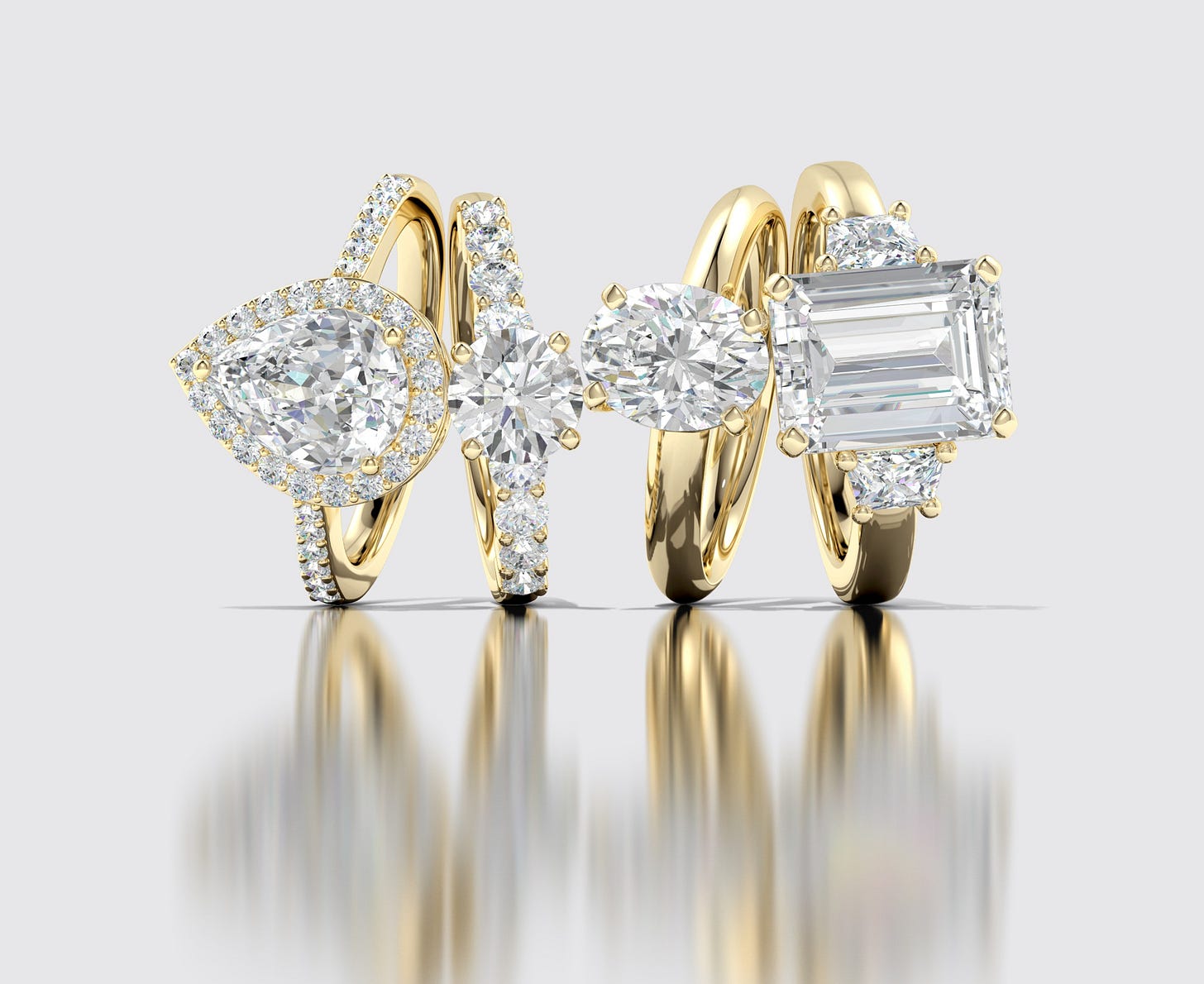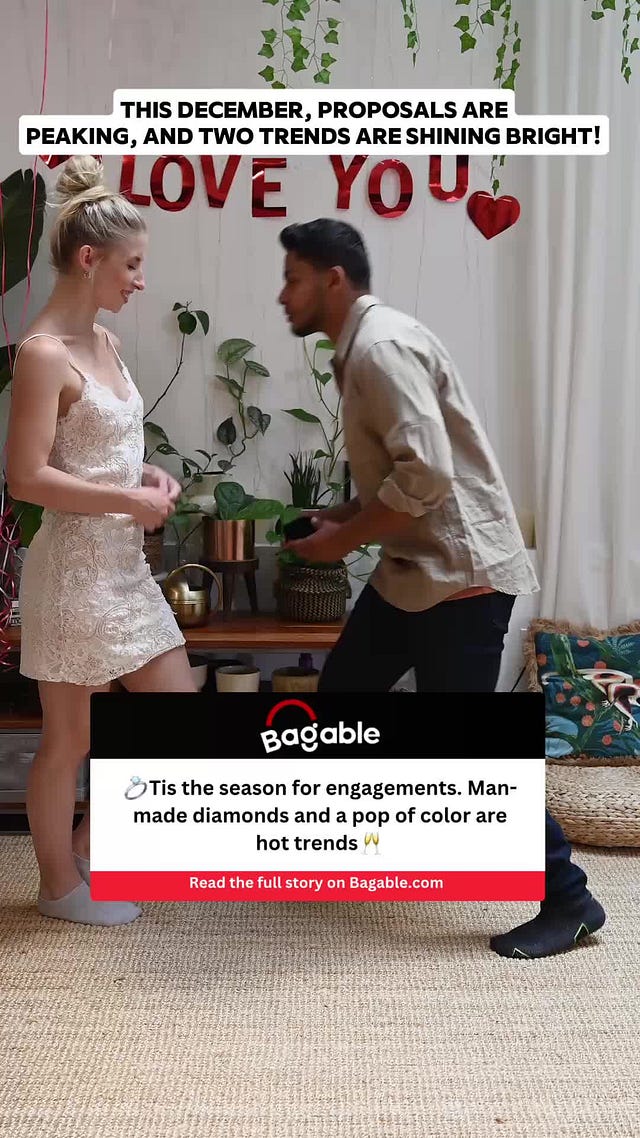💍Tis the season for engagements. Man-made diamonds and a pop of color are hot trends🥂
December is a peak month not only for holiday festivities but also celebrations of a different kind.
The last month of the year is a very popular period for proposals. This year, as many as 21% of couples in the US are expected to get engaged in December, according to the 2024 Global Wedding Report from wedding planning website The Knot.
With New Year’s Eve — one of the most heavily-favored days to pop the question — fast approaching, searches for engagement rings have revved up over the past month on Google, according to Google Trends data.
Those searches reveal two standout trends: lab-made diamonds are still outpacing interest in natural diamonds, and color gemstones are top of mind with engagement ring buyers.
Google said search interest for lab diamonds surpassed that for natural diamonds in 2019 and has continued to be on the rise. In the past 12 months, Google Trends data showed lab-made diamonds had 69% share of search interest versus 31% for natural diamonds.
Ankur Daga, CEO of Angara, is staying abreast of these trends.
Angara, a Los Angeles-based direct-to-consumer fine jewelry brand with about $100 million in annual sales, specializes in diamonds, color gemstones and pearls.
Daga said Angara is in the midst of its busiest time of the year for engagement ring orders, which typically are the months of November and December.
“Over this holiday season we expect to sell hundreds of engagement rings a day,” Daga said in an interview with Bagable.com. The family-owned business employs 500 people with offices around the world.
“We’re also completely vertically integrated. We source and buy our own gemstones, design and manufacture jewelry and sell directly to our customers. Every piece we sell is made to order,” explained Daga.
Angara has also managed to fast track that process by fully automating it.
“What’s unique about us is that we’ve compressed a six-month time frame for a custom piece into 24 hours,” he said.
“For example, if you ordered a piece now, it would go into production a couple of hours later, primarily in Bangkok, India or in Los Angeles,” he said. “It would take eight to 12 hours to cast. Then we would hand-select the diamonds and the color stones that you've chosen, hand set them, polish Rhodium quality control, and by the time you wake up, it would ship out.”
Just before hitting the year-end crunch time, Angara commissioned a survey in October of 2,000 people in committed relationships to glean insights about their engagement ring preferences.
The results, Daga said, showed how “Gen Z is rewriting the rules of the diamond industry.”
Lab-made diamonds becoming the norm
For younger consumers, lab-made diamonds are solidifying their status as the new standard for “affordable luxury and conscious consumption,” said Daga.
A majority of Gen Z survey respondents said they preferred a 3 carat lab-grown diamond to a 1 carat natural mined diamond.
Lab-created diamonds now make up over half (52%) of all center stones in an engagement ring, up from 46% last year, which The Knot described as “one of the biggest shifts in engagement ring trends.”
Industry experts said Millennials and GenZers prefer bigger stones such as 2 carat and 3 carat diamonds. They’re able to afford them because of their preference for the lab-made options, which are at least 70% cheaper than their natural counterparts.
The year-to-date price for a 2 carat natural diamond ring, for example, has an average price tag of $9,867, compared to $2,905 for a 2 carat lab-made diamond ring. A 3 carat natural diamond ring has an average price tag of about $14,827, versus $4,130 for a lab diamond option.
“These are prices for all rings, including engagement rings, which pushes up the average price,” Edahn Golan, jewelry industry analyst and founder of Edahn Golan Diamond Research & Data, told Bagable.com.
“When we sell diamond engagement rings now, 55% of units sold are with lab diamonds,” said Daga. “I fully expect this to get to 80% lab and 20% natural diamonds. On our site you can buy a 3 carat lab diamond ring for $3,000 or a 3 carat natural diamond ring for $30,000.”
Color is popping up in rings
Both Daga and his wife, whose families have been in the jewelry business for generations, have a deep passion for color gemstones such as sapphires, emeralds and rubies.
Industry trends indicate that color gemstones are making a comeback in engagement rings.
For Angara, as much as 60% of engagement rings it sells have a color center gemstone.
“Historically, if you look at 1600s onwards until the 1950s color stones were really the majority of the jewelry industry before diamonds were popularized. Sapphires, emeralds and rubies were always the top three most popular color gemstones.”
In the US, Daga said 15% to 18% of engagement rings currently sold have a color gemstone center, with sapphire being the most desired color gemstone.
“Some color gemstones, such as Tanzanite, are even rarer than natural diamonds,” he said. “The survey data showed us that across the age spectrum, it’s become much more acceptable is having a color gemstone engagement ring. Celebrities have also brought this trend to the forefront.”
But in terms of their cost, color gemstones are trending in the opposite direction of diamonds.
“While diamond prices have fallen by half over the last couple of years, color gemstones such as emeralds, rubies and sapphires are doubling in price every couple of years,” said Daga.
“The customer for a color gemstone ring gravitates towards a specific look. Most are not buying them as a status symbol, something that has driven diamond sales historically,” he said. “It’s a deliberate preference for selecting an option they find more attractive.”









